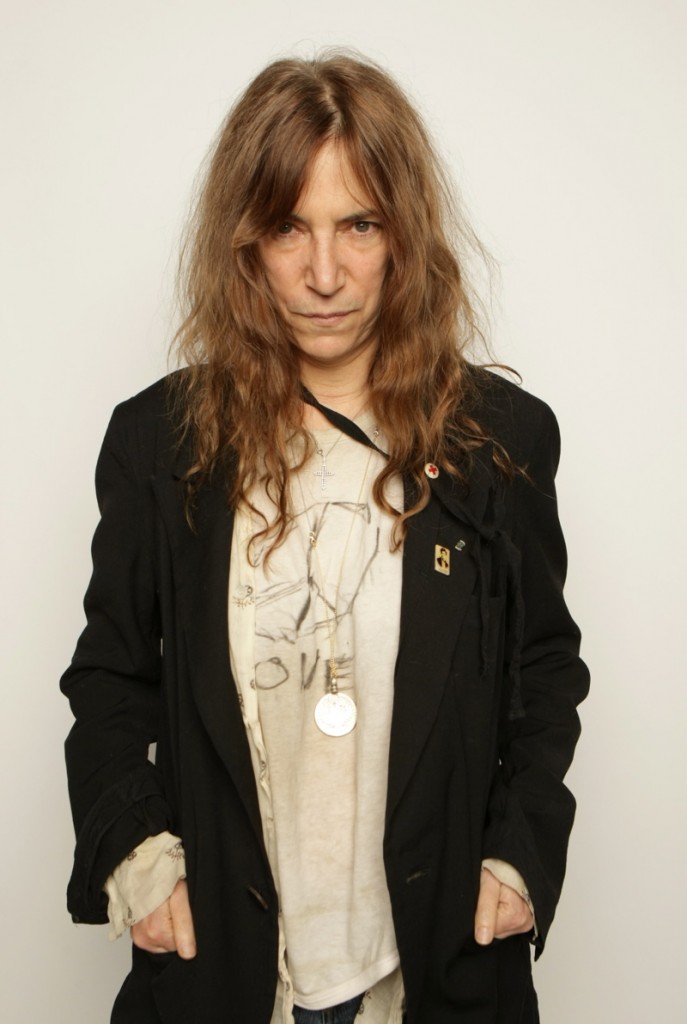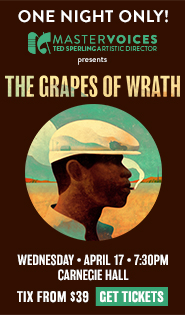A still-primal Patti Smith channels Hildegard at the Met Museum
The question arises: Why would New York Classical Review cover a concert by Patti Smith?
True, the event took place Friday within the Metropolitan Museum of Art’s hallowed confines, and it was billed as a tribute to Hildegard of Bingen, the twelfth-century polymath lately turned chart-topping composer and Doctor of the Roman Catholic Church, one of only four women so honored to date.
Hildegard’s music was piped into the Grace Rainey Rogers Auditorium before and after Friday’s concert, and Jesse Paris Smith (polymath Patti’s daughter) and techno drummer Eric Hoegemeyer sampled it in their suite of five pieces built around Hildegard’s visions. Many words by the abbess were spoken or intoned. But the musical highlights, including such classic songs as Dancing Barefoot and Because the Night, belonged to Smith and her co-writers and were performed in a straight-out rock-and-roll style.
Like Maria Callas, Smith can’t be bothered to make music in a pretty or ingratiating way: she deals in matters far too primal and grave. Her quietly incandescent memoir Just Kids tells of hunger, cold, and sickness sustained for the sake of art and to escape mindless, soul-killing drudgery. She has plied her craft humbly, patiently, and painstakingly, a kindred spirit to the likes of composer George Benjamin and Leonard Cohen.
Smith and Cohen are by a wide margin today’s most serious and important writers of song, “classical” or not. But that judgment, too, is partial and biased, as is the idea that a working-class woman with a nasal voice, unkempt hair, and a guitar could not possibly have things just as momentous to say as, oh, Mozart and Beethoven.
Smith’s program was a tribute not only to Hildegard but also to her fellow female visionary Julia Margaret Cameron, whose photographs are the subject of a Met exhibition through January 5. “I’m so beyond gender,” Smith joked after introducing the song In My Blakean Year as “a little nod to the fellows,” characterizing the remark as “part of [her] bronchitis.” But the idea of women’s vision remains fraught. Taught to be seen but not necessarily to see, women who put forward their views have suffered mockery (Cameron for her allegedly faulty technique) and belittlement (Hildegard downplayed her own efforts and attributed her music and theological texts to the Divine).
The voices of many different women wove their way through Smith’s concert. Over flute sounds, xylophone bubbles, and the noodling of Tom Verlaine’s electric guitar, Smith improvised on an episode from Lewis Carroll’s Alice’s Adventures in Wonderland. Projected on the screen behind her was Cameron’s photograph of Alice Liddell as a strong, challenging adult. (As a child Liddell had inspired Carroll’s novel.) Smith emphasized Alice as an active being: “She took the bottle that said ‘drink me,’ and drank.”
She declaimed Hildegard’s wild apparitions of “white fire” and “a man the color of sapphire” over the low drone of a guitar, samples of the abbess’s music, and gritty, inchoate, static-like noises: perhaps the earthly echoes of the “living light” that Hildegard heard (and not saw). Smith read Hildegard’s reflections on gold, silver, iron, and steel, which she saw not as the stuff of lucre or weaponry but as treasures infused with the same heavenly “vitality” that quickened “plants, trees, and stones.”
Smith connected her mother’s death in 2002 with the “sweet scent” that descended upon Hildegard in her rapture, “like a gentle breath exhaled by my mother.” Backed by her daughter on piano and the lustrous, dewy guitar playing of Verlaine and Lenny Kaye, she sang her own Mother Rose, telling of a woman who “turned to gold” and “rose into the light,” unleashing ripples of correspondences among earthly parents, Mary the mother of Jesus, and the miraculous rosebush of Saint Mary’s Cathedral in Hildesheim.
Correspondences came to the fore in the final part of the performance. With a projection of William Blake’s The Death of the Virgin behind her, Smith pointed out that Hildegard and Smith’s mother shared a September 17 passing day, that a double rainbow shone the day that her daughter Jesse was born, and that the correspondences sung by Baudelaire and others were everywhere: “All we have to do is keep ourselves open and we’ll see them.” The repeated incantations of “Oh God I fell for you from” from Dancing Barefoot took on new meanings, and Smith paid homage to her twelfth-century forebear by revising one of her most celebrated lyrics: “Because the night belongs to Hildegard.”
Smith closed the concert with a prayer she had written as a child for health and love and the grace to be “a saint in any form.” That is a good wish for all who are receptive to great beauty and artistry in whatever mode they may come.
Upcoming musical events at the Metropolitan Museum of Art include a John Zorn celebration on September 28; the Alarm Will Sound in a program of music by Adès, Ives, Ligeti, and Wagner on October 11; and the first concert in the Calder Quartet’s Bartók cycle on October 12. Janet Cardiff’s sound installation “The Forty-Part Motet” is in the Fuentidueña Chapel at the Cloisters through December 8. metmuseum.org; 212.570.3949.



